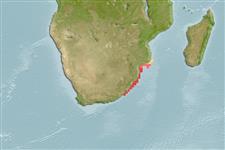Actinopterígios (peces con aletas radiadas) >
Perciformes (Perch-likes) >
Serranidae (Sea basses: groupers and fairy basslets) > Epinephelinae
Etymology: Epinephelus: Greek, epinephelos = cloudy (Ref. 45335). More on author: Boulenger.
Medioambiente / Clima / Gama
Ecología
; marino asociado a arrecife; no migratorio; rango de profundidad 10 - 100 m (Ref. 5222), usually 30 - 80 m (Ref. 89707). Subtropical, preferred ?; 23°S - 35°S, 29°E - 38°E (Ref. 5222)
Distribución
Países | Áreas FAO | Ecosistemas | Ocurrencias, apariciones | Point map | Introducciones | Faunafri
Western Indian Ocean: Quissico, Mozambique to East London, South Africa.
Tamaño / Peso / Age
Maturity: Lm ? range ? - ? cm
Max length : 100.0 cm TL macho / no sexado; (Ref. 5222); peso máximo publicado: 13.0 kg (Ref. 4787)
Espinas dorsales (total): 11; Radios blandos dorsales (total): 14; Espinas anales 3; Radios blandos anales: 8. Distinguished by the following characteristics: head, body, dorsal and caudal fins pale brown, with numerous dark brown spots; ventral parts of head and body lacking spots; juveniles, many of the spots merge to form double spots; prominent dark brown streak along the upper edge of maxillary groove; margin of interspinous dorsal fin membranes yellow or gold; soft dorsal and anal fin dusky distally, with prominent white edge; upper and lower edges of posterior part of caudal fin white edged; pectoral fins yellowish or reddish orange; body depth less than head length, 2.6-3.0 times in SL; head length 2.3-2.5 times in SL; angular preopercle, 2-3 enlarged serrae at the angle; upper edge of operculum straight or convex; naked maxilla, without a step on ventral edge; caudal fin truncate, corners rounded in adults, posterior edge convex in juveniles; lateral body scales ctenoid, with few auxiliary scales in adults (Ref. 089707).
Found over rocks and corals at depths of at least 100 m. Feeds mainly on benthic invertebrates, also on fishes and squids (Ref. 4787, 5213).
Life cycle and mating behavior
Madurez | Reproducción | Puesta | Huevos | Fecundidad | Larva
Heemstra, P.C. and J.E. Randall, 1993. FAO Species Catalogue. Vol. 16. Groupers of the world (family Serranidae, subfamily Epinephelinae). An annotated and illustrated catalogue of the grouper, rockcod, hind, coral grouper and lyretail species known to date. Rome: FAO. FAO Fish. Synop. 125(16):382 p. (Ref. 5222)
IUCN Red List Status (Ref. 115185)
CITES (Ref. 94142)
Not Evaluated
Threat to humans
Harmless
Human uses
Pesquerías: pesquerías de subsistencia
Más información
ReferenciasAcuiculturaPerfil de acuiculturaRazasGenéticaFrecuencias de alelosheritabilidadEnfermedadesProcesamientoMass conversion
ColaboradoresImágenesStamps, CoinsSonidosCiguateraVelocidadTipo de nataciónSuperficie branquialOtolitosCerebrosVisión
Herramientas
Special reports
Download XML
Fuentes de Internet
